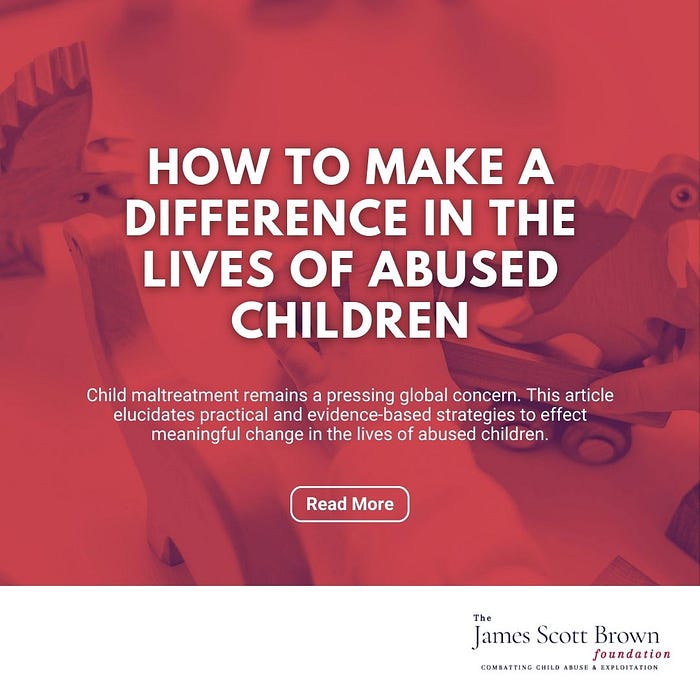How to Make a Difference in the Lives of Abused Children by James Scott Brown Foundation
by James Scott Brown Foundation

Abstract:
Child maltreatment remains a pressing global concern. This article elucidates practical and evidence-based strategies to effect meaningful change in the lives of abused children. Grounded in academic research and expertise in child abuse, trauma, and exploitation, the ensuing discourse presents five key approaches to supporting victims of maltreatment.
1.Implement early intervention programs:
Timely intervention can mitigate the adverse effects of child abuse and foster resilience. Multi-disciplinary programs focusing on parental support, mental health, and education play a crucial role in breaking the cycle of maltreatment (Wolfe & McIsaac, 2011).
2. Support trauma-informed care:
Trauma-informed care, a therapeutic approach that acknowledges the impact of traumatic experiences on individuals, can facilitate healing in abused children. Advocating for the adoption of such methods in schools, healthcare, and social service settings can create safe environments for recovery (Ko et al., 2008).
3. Cultivate safe spaces and relationships:
Establishing safe, nurturing relationships with trusted adults can profoundly benefit abused children. Encourage mentors, teachers, and community members to offer support and guidance, fostering a sense of stability and belonging (Turner et al., 2017).
4. Advocate for mental health services:
Access to appropriate mental health services is paramount for addressing the psychological ramifications of abuse. Lobby for increased funding, availability, and accessibility of services tailored to the unique needs of child abuse victims (Wolfe & McIsaac, 2011).
5. Engage in community-based prevention:
Community-wide prevention initiatives, such as educational workshops and awareness campaigns, can contribute to the reduction of child abuse. Encouraging collaboration between families, schools, and local organizations can foster a protective network for vulnerable children (Ko et al., 2008).
Conclusion:
The profound impact of child abuse necessitates concerted efforts to support affected individuals. The aforementioned strategies, rooted in evidence-based practice and academic research, offer a framework for making a tangible difference in the lives of abused children.
References:
Ko, S. J., Ford, J. D., Kassam-Adams, N., Berkowitz, S. J., Wilson, C., Wong, M., … & Layne, C. M. (2008). Creating trauma-informed systems: Child welfare, education, first responders, health care, juvenile justice. Professional Psychology: Research and Practice, 39(4), 396–404.
Turner, H. A., Finkelhor, D., & Ormrod, R. (2017). The effects of adolescent victimization on self-concept and depressive symptoms. Child Maltreatment, 22(1), 3–13.
Wolfe, D. A., & McIsaac, C. (2011). Distinguishing between poor/dysfunctional parenting and child emotional maltreatment. Child Abuse & Neglect, 35(10), 802–813.
Read more at the James Scott Brown Foundation.
Comments
Post a Comment